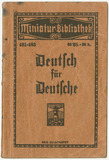Bodo Uhse: Die erste Schlacht, camouflage publication (1938)
Bodo Uhse: Die erste Schlacht, camouflage publication (1938)
Die deutschen Schriftsteller gehen langsam an den ungeheuren Stoff des spanischen Bürgerkriegs. Langsam, weil die meisten von ihnen bis vor kurzem mitgekämpft haben […], langsam, weil eben ein solcher Stoff den kürzeren oder längeren Abstand braucht, der das Erlebnis zur Erfahrung macht.
[Germany’s writers are slowly dealing with the formidable material of the Spanish Civil War. Slowly, because most of them fought in it until a short time ago […], slowly, because material like this has to be dealt with either fast or from a distance, in order to turn what was lived through into experience. (ed. trans.)]
Anna Seghers about Die erste Schlacht
Bodo Uhse’s report about the battalion that was named after the German communist Edgar André who was executed in 1936, which fought in the Spanish Civil War in the 9th and later on in the 11th International Brigade, was released in 1938 as a book published by the Strasbourg publisher Editions Prométhée. Brought to Germany and disseminated there, this literary chronicle of the events could only be released in the form of a camouflage publication – reduced in size photographically and hidden behind the book cover of Gerhart Ellert’s Wallenstein novel.
Uhse describes the beginnings of the battalion, which trained in Albacete and was then deployed in Madrid in October and November 1936. He writes about the enthusiasm and thirst for action of the young voluntary fighters, but also about their lack of experience and inadequate coordination. Uhse, who himself was first of all a reporter and later a political commissar in the Spanish Civil War, was not able to draw on personal experiences, but used subsequent records and interviews with those involved to write his report. The protective covering of the camouflage edition also contained the name of an author who published under a pseudonym. The name Gerhart Ellert was a front for the Austrian writer Gertrud Schmirger, who had been writing historical novels released by Viennese publisher Speidel Verlag Wien since 1933. The woodcut used for the cover illustration of the novel about Wallenstein was done by Karl Stratil who created a number of historical portraits in occupied Prague and later in the GDR.




